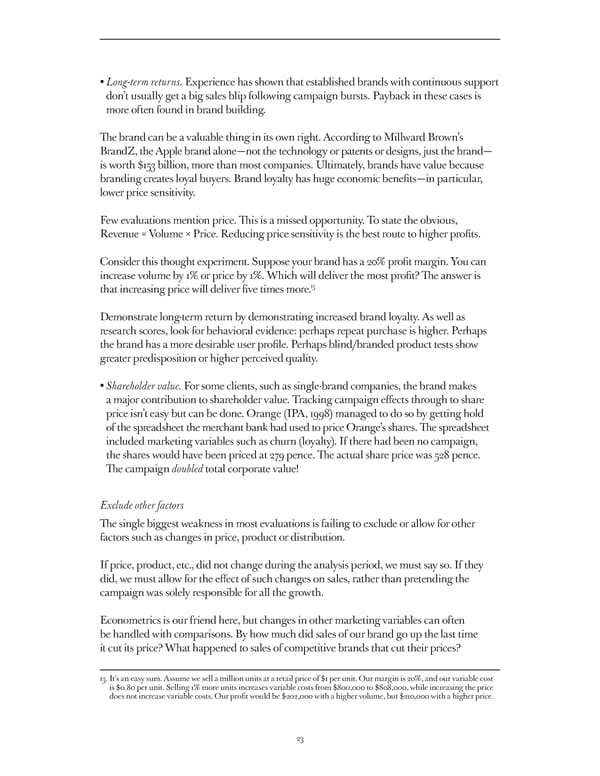• Long-term returns. Experience has shown that established brands with continuous support don’t usually get a big sales blip following campaign bursts. Payback in these cases is more often found in brand building. The brand can be a valuable thing in its own right. According to Millward Brown’s BrandZ, the Apple brand alone — not the technology or patents or designs, just the brand — is worth $153 billion, more than most companies. Ultimately, brands have value because branding creates loyal buyers. Brand loyalty has huge economic benefits — in particular, lower price sensitivity. Few evaluations mention price. This is a missed opportunity. To state the obvious, Revenue = Volume × Price. Reducing price sensitivity is the best route to higher profits. Consider this thought experiment. Suppose your brand has a 20% profit margin. You can increase volume by 1% or price by 1%. Which will deliver the most profit? The answer is 13 that increasing price will deliver five times more. Demonstrate long-term return by demonstrating increased brand loyalty. As well as research scores, look for behavioral evidence: perhaps repeat purchase is higher. Perhaps the brand has a more desirable user profile. Perhaps blind/branded product tests show greater predisposition or higher perceived quality. • Shareholder value. For some clients, such as single-brand companies, the brand makes a major contribution to shareholder value. Tracking campaign effects through to share price isn’t easy but can be done. Orange (IPA, 1998) managed to do so by getting hold of the spreadsheet the merchant bank had used to price Orange’s shares. The spreadsheet included marketing variables such as churn (loyalty). If there had been no campaign, the shares would have been priced at 279 pence. The actual share price was 528 pence. The campaign doubled total corporate value! Exclude other factors The single biggest weakness in most evaluations is failing to exclude or allow for other factors such as changes in price, product or distribution. If price, product, etc., did not change during the analysis period, we must say so. If they did, we must allow for the effect of such changes on sales, rather than pretending the campaign was solely responsible for all the growth. Econometrics is our friend here, but changes in other marketing variables can often be handled with comparisons. By how much did sales of our brand go up the last time it cut its price? What happened to sales of competitive brands that cut their prices? 13. It’s an easy sum. Assume we sell a million units at a retail price of $1 per unit. Our margin is 20%, and our variable cost is $0.80 per unit. Selling 1% more units increases variable costs from $800,000 to $808,000, while increasing the price does not increase variable costs. Our profit would be $202,000 with a higher volume, but $210,000 with a higher price. 23
 A Guide To Effectiveness Page 22 Page 24
A Guide To Effectiveness Page 22 Page 24